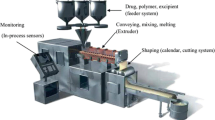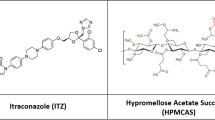Abstract
Formulation of an amorphous solid dispersion (ASD) is one of the methods commonly considered to increase the bioavailability of a poorly water-soluble small-molecule active pharmaceutical ingredient (API). However, many factors have to be considered in designing an API–polymer system, including any potential changes to the physical stability of the API. In this study, the tendency of ASD systems containing a poorly water-soluble API and a polymer to undergo amorphous–amorphous phase separation was evaluated following exposure to moisture at increasing relative humidity. Infrared spectroscopy was used as the primary method to investigate the phase behavior of the systems. In general, it was observed that stronger drug–polymer interactions, low-ASD hygroscopicity, and a less hydrophobic API led to the formation of systems resistant to moisture-induced amorphous–amorphous phase separation. Orthogonal partial least squares analysis provided further insight into the systems, confirming the importance of the aforementioned properties. In order to design a more physically stable ASD that is resistant to moisture-induced amorphous–amorphous phase separation, it is important to consider the interplay between these properties.












Similar content being viewed by others
References
Hancock BC, Parks M. What is the true solubility advantage for amorphous pharmaceuticals? Pharm Res. 2000;17(4):397–404.
Konno H, Taylor LS. Ability of different polymers to inhibit the crystallization of amorphous felodipine in the presence of moisture. Pharm Res. 2008;25(4):969–78.
Rumondor ACF, Stanford LA, Taylor LS. Effects of polymer type and storage relative humidity on the kinetics of felodipine crystallization from amorphous solid dispersions. Pharm Res. 2009;26(12):2599–606.
Marsac PJ, Konno H, Rumondor ACF, Taylor LS. Recrystallization of nifedipine and felodipine from amorphous molecular level solid dispersions containing poly(vinylpyrrolidone) and sorbed water. Pharm Res. 2008;25(3):647–56.
Marsac PJ, Rumondor ACF, Nivens DE, Kestur US, Stanciu L, Taylor LS. Effect of temperature and moisture on the miscibility of amorphous dispersions of felodipine and poly(vinyl pyrrolidone). J Pharm Sci. 2010;99(1):169–85.
Rumondor ACF, Taylor LS. Effects of polymer hygroscopicity on the phase behavior of amorphous solid dispersions in the presence of moisture. Mol Pharm. 2010;7(2):477–90.
Rumondor ACF, Marsac PJ, Stanford LA, Taylor LS. Phase behavior of poly(vinylpyrrolidone) containing amorphous solid dispersions in the presence of moisture. Mol Pharm. 2009;6(5):1492–505.
Vasanthavada M, Tong WQ, Joshi Y, Kislalioglu MS. Phase behavior of amorphous molecular dispersions-II: role of hydrogen bonding in solid solubility and phase separation kinetics. Pharm Res. 2005;22(3):440–8.
Rumondor ACF, Konno H, Marsac P, Taylor L. Analysis of the moisture sorption behavior of amorphous solid dispersions containing hydrophobic drugs. J Appl Polymer Sci. 2010;117(2):1055–63.
Bylesjö M, Rantalainen M, Cloarec O, Nicholson JK, Holmes E, Trygg J. OPLS discriminant analysis: combining the strengths of PLS-DA and SIMCA classification. J Chemometr. 2006;20:341–51.
Rumondor ACF, Ivanisevic I, Bates S, Alonzo DE, Taylor LS. Evaluation of drug-polymer miscibility in amorphous solid dispersion systems. Pharm Res. 2009;26(11):2523–34.
Broman E, Khoo C, Taylor LS. A comparison of alternative polymer excipients and processing methods for making solid dispersions of a poorly water soluble drug. Int J Pharm. 2001;222(1):139–51.
Taylor LS, Zografi G. Spectroscopic characterization of interactions between PVP and indomethacin in amorphous molecular dispersions. Pharm Res. 1997;14(12):1691–8.
Allen FH. The Cambridge Structural Database: a quarter of a million crystal structures and rising. Acta Cryst. 2002;B58:380–8.
Qian F, Huang J, Zhu Q, Haddadin R, Gawel J, Garmise R, et al. Is a distinctive single Tg a reliable indicator for the homogeneity of amorphous solid dispersion? Int J Pharm. 2010;395(1–2):232–5.
Ivanisevic I. Physical stability studies of miscible amorphous solid dispersions. J Pharm Sci. 2010;99(9):4005–12.
Marsac P, Li T, Taylor L. Estimation of drug-polymer miscibility and solubility in amorphous solid dispersions using experimentally determined interaction parameters. Pharm Res. 2009;26(1):139–51.
Leuner C, Dressman J. Improving drug solubility for oral delivery using solid dispersions. Eur J Pharm Biopharm. 2000;50(1):47–60.
Serajuddin ATM. Solid dispersion of poorly water-soluble drugs: early promises, subsequent problems, and recent breakthroughs. J Pharm Sci. 1999;88(10):1058–66.
Tang XLC, Pikal MJ, Taylor LS. A spectroscopic investigation of hydrogen bond patterns in crystalline and amorphous phases in dihydropyridine calcium channel blockers. Pharm Res. 2002;19(4):477–83.
Wolkers WF, Oliver AE, Tablin F, Crowe JH. A Fourier-transform infrared spectroscopy study of sugar glasses. Carbohydr Res. 2004;339(6):1077–85.
Eriksson L, Johansson E, Kettaneh-Wold N, J.Trygg, Wikström C, Wold S. Multivariate and Megavariate Data Analysis Basic Principles and Applications (Part I): Umetrics; 2006.
Laurence C, Brameld KA, Graton J, Le Questel JY, Renault E. The pK(BHX) database: toward a better understanding of hydrogen-bond basicity for medicinal chemists. J Med Chem. 2009;52(14):4073–86.
The Merck Index: An Encyclopedia of Chemicals, Drugs, and Biologicals. 14th ed. al. MJone, editor. Whitehouse Station, NJ: Merck & Co., Inc.; 2006.
Thompson JE. A Practical Guide to Contemporary Pharmacy Practice. 3rd ed. Baltimore: Lippincott Williams & Wilkins; 2009.
Yalkowsky SH, He Y. Handbook of Aqueous Solubility Data: CRC Press; 2003.
Chi SC, Jun HW. Release rates of ketoprofen from poloxamer gels in a membraneless diffusion cell. J Pharm Sci. 1991;80(3):280–3.
Baird JA, Van Eerdenbrugh B, Taylor LS. A classification system to assess the crystallization tendency of organic molecules from undercooled melts. J Pharm Sci. 2010;99(9):3787–806.
Acknowledgments
Matthew J. Jackson is gratefully acknowledged for his help in collecting infrared results. This work is funded by Purdue Research Foundation and Merck Research Laboratories. This work was supported in part by a grant from the Lilly Endowment, Inc., to Purdue University School of Pharmacy and Pharmaceutical Sciences. BVE is a Postdoctoral Researcher of the ‘Fonds voor Wetenschappelijk Onderzoek’, Flanders, Belgium.
Author information
Authors and Affiliations
Corresponding author
Rights and permissions
About this article
Cite this article
Rumondor, A.C.F., Wikström, H., Van Eerdenbrugh, B. et al. Understanding the Tendency of Amorphous Solid Dispersions to Undergo Amorphous–Amorphous Phase Separation in the Presence of Absorbed Moisture. AAPS PharmSciTech 12, 1209–1219 (2011). https://doi.org/10.1208/s12249-011-9686-y
Received:
Accepted:
Published:
Issue Date:
DOI: https://doi.org/10.1208/s12249-011-9686-y




